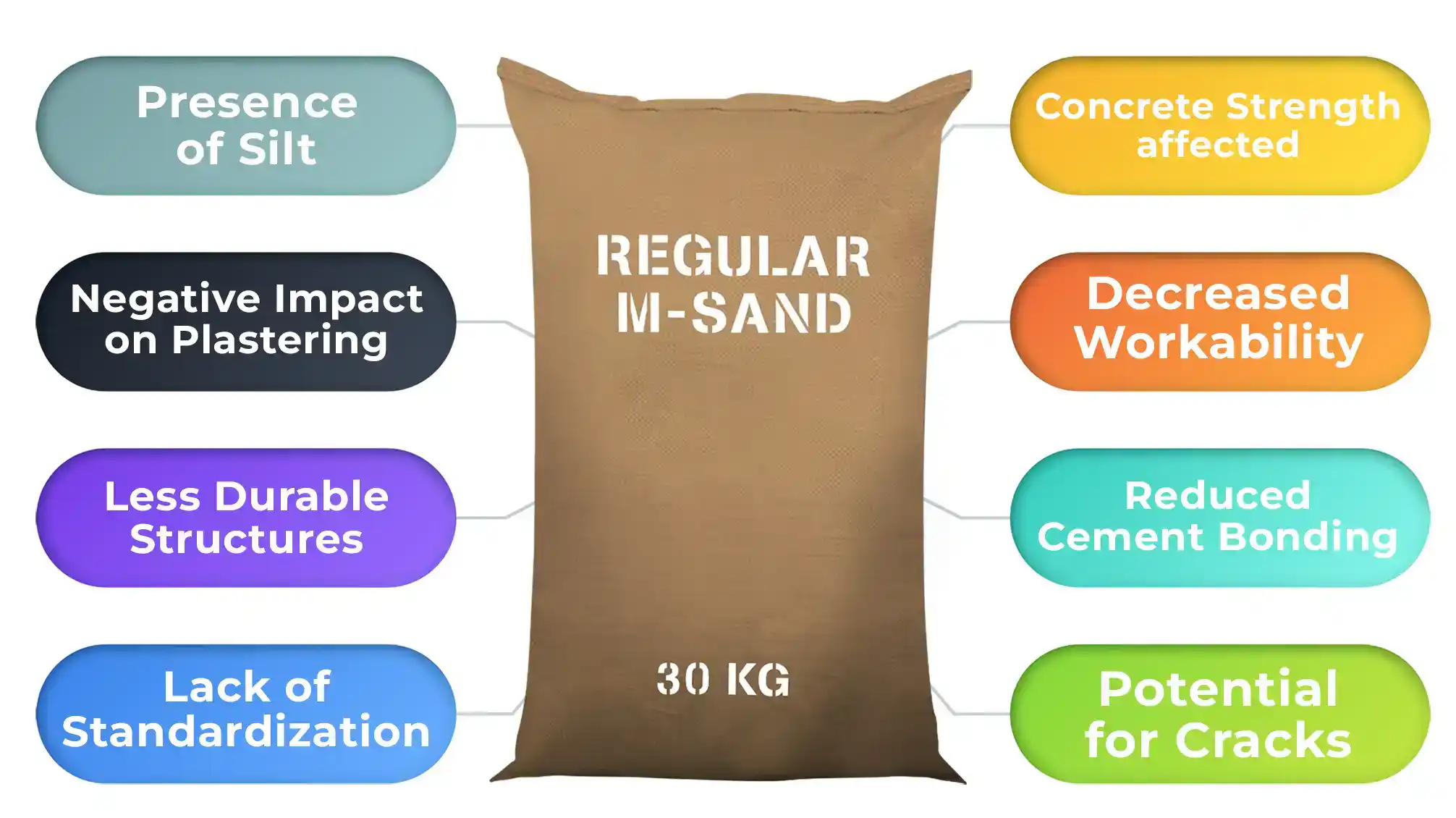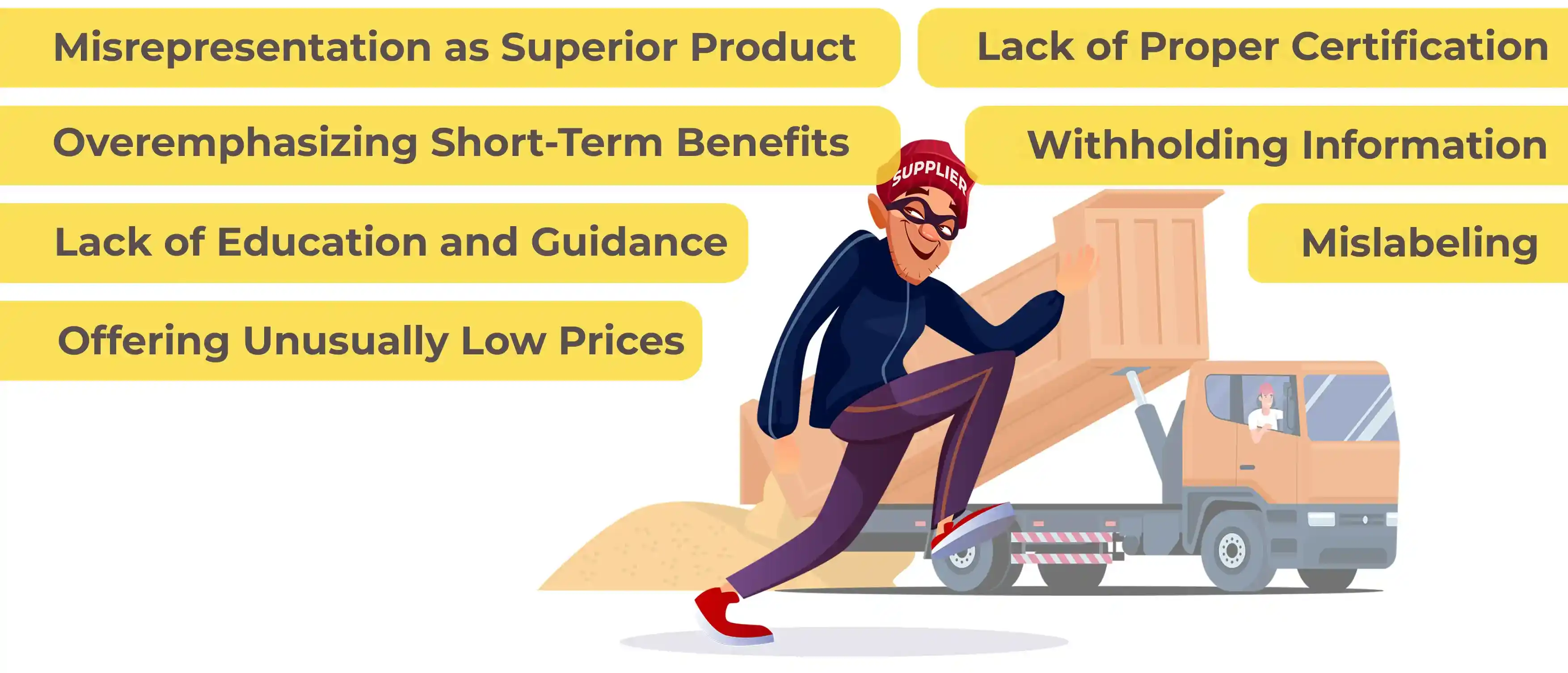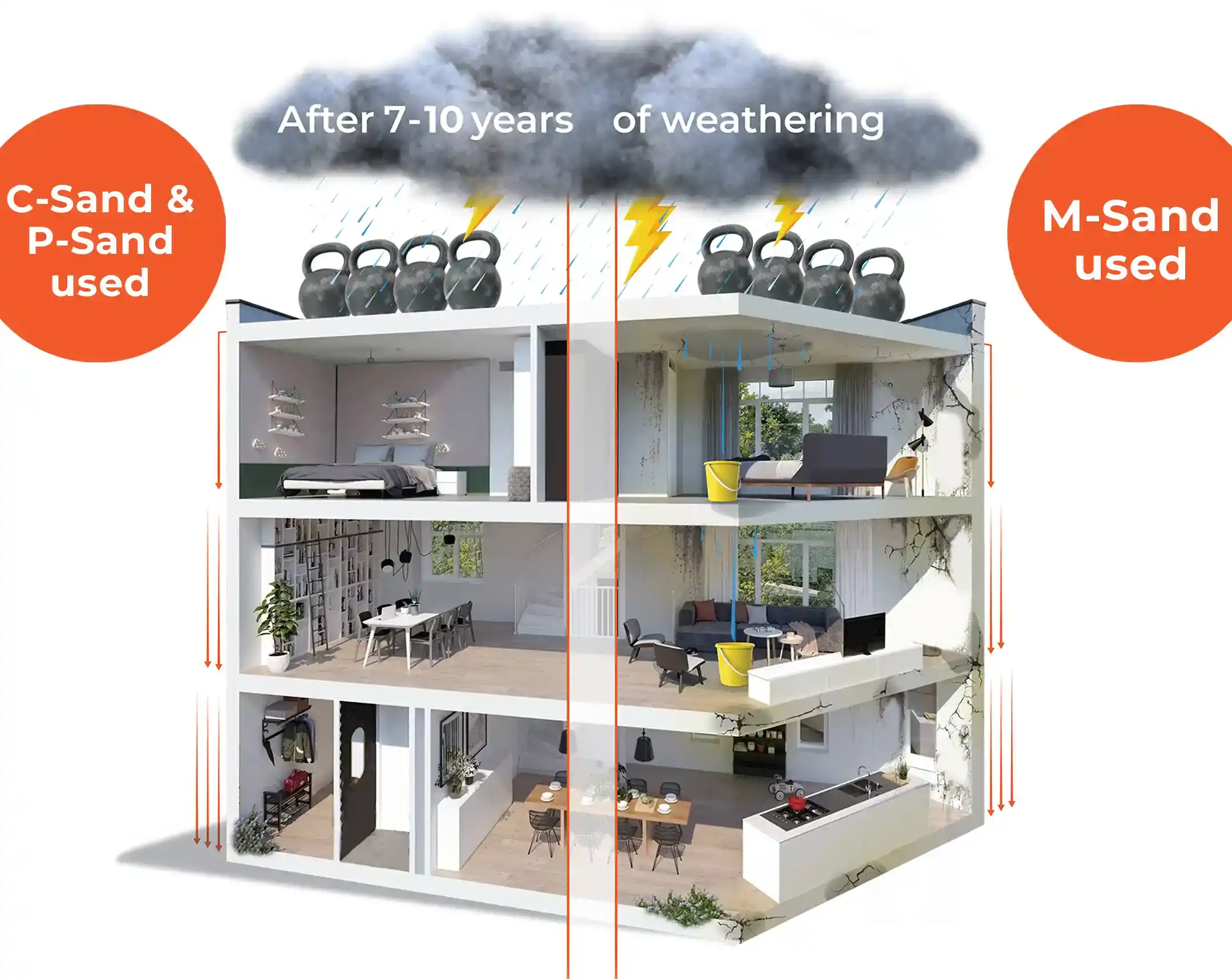
M sand, or manufactured sand, is the most used sand for construction. However, there are critical factors that you need to consider before selecting M Sand for your home. In this guide, we will discuss the properties of M sand, how to save ourselves from a few fraud suppliers, the best alternatives of M sand, along with providing valuable insights for making informed decisions.
Table of Contents:
What Is M Sand?
Properties Of M sand: Understanding the Drawbacks
How Sand Suppliers Exploit Customer Lack of Awareness Regarding M Sand
The Perils of Purchasing Manufactured Sand
Concrete Sand: Superior Alternative to M Sand
Concrete Sand: The Essential Ingredient for Superior Concrete Production
Frequently Asked Question
What Is M Sand?
M sand or manufactured sand is artificial sand manufactured by crushing large stones into smaller particles.
Properties of Manufactured Sand:

You must understand the properties of M Sand or any sand you use for your home, as explained below.
Presence of Silt, Dust, and Impurities:
One of the main concerns with M sand is the presence of silt and other impurities. This silt will adversely impact the bonding of concrete. Always make sure to use sand, which is 100% silt-free, for a durable home.
Effect on Concrete Strength:
Concrete plays the most important role in construction. The presence of silt in M sand will disturb the concrete strength, resulting in reduced compressive strength and a weaker structure.
Decreased Workability:
Workability refers to the ease of mixing of sand and concreting during construction. Due to the presence of silt content in M sand, workability could be better.
Reduced Bonding with Cement Paste:
The bonding between cement and sand is important for concreting. The presence of impurities and dust particles in M sand can create a barrier between the cement and sand, reducing bonding efficiency. As a result, the concrete will exhibit poor cohesion and decreased load-bearing capacity.
Potential for Cracks and Shrinkage:
The improper mix of M Sand in concrete can increase shrinkage and cracking. Excessive silt content can cause water retention, leading to shrinkage as water evaporates during curing. Concrete cracking can compromise its integrity, affecting the longevity and performance of the structure.
Impact on Plastering and Masonry Work:
In addition to concrete, M Sand's silt content can also affect plastering and masonry work. The presence of fine particles can lead to a rough and uneven surface, hindering the proper adhesion of plaster or mortar. This can result in poor-quality finishes and compromised aesthetics of the building.
Lack of Standardization:
Manufactured Sand lacks standardized grading, and its properties vary significantly depending on the source and manufacturing process. This lack of uniformity makes ensuring consistent quality in construction projects challenging, leading to results uncertain.
How Sand Suppliers Exploit Customer Lack of Awareness Regarding M Sand?

The demand for Manufactured Sand has surged in the construction industry due to its advantages over natural river sand. However, the need for more awareness among customers about its limitations has created a ripe opportunity for unscrupulous sand suppliers to take advantage of their ignorance. Here are some common tactics used by such suppliers to deceive customers:
1. Withholding Information:
Some dishonest suppliers may deliberately withhold critical information about the drawbacks of M Sand. They may downplay or completely omit details about the presence of silt dust and impurities and its potential negative impact on construction materials. This lack of transparency misleads buyers into believing that M Sand is a flawless and reliable substitute for river sand.
2. Misrepresentation as Superior Product:
In an effort to boost sales, unethical suppliers may falsely claim that M Sand is superior to natural river sand without providing concrete evidence. They may exaggerate its benefits while conveniently omitting its limitations. This creates a false sense of confidence in customers, leading them to believe they are making a smarter choice by opting for M Sand.
3. Lack of Proper Certification:
Reputable sand suppliers ensure their products undergo thorough testing and adhere to industry standards. However, dishonest suppliers may need to give customers proper certifications or test results. Verifiable documentation would make it easier for customers to gauge the quality and suitability of the M Sand they purchase.
4. Mislabeling:
Suppliers may sometimes label their sand as "high-quality M Sand" or "pure M Sand" without substantial evidence supporting such claims. This mislabeling misleads customers into believing that they are receiving a premium product when, in reality, the sand may not meet the necessary construction standards.
5. Offering Unusually Low Prices:
Unscrupulous suppliers may use attractive pricing to lure customers into buying their M Sand. While low prices may seem appealing, they often indicate compromised quality and a higher likelihood of silt content and impurities. Customers enticed by low prices may unknowingly compromise the integrity of their construction projects.
6. Lack of Education and Guidance:
Dishonest suppliers may not invest time in educating customers about the properties and limitations of M Sand. Instead, they may rush customers through the purchasing process without explaining the potential risks. This lack of education leaves customers vulnerable to making uninformed decisions that could have long-term consequences.
7. Overemphasizing Short-Term Benefits:
Some suppliers focus solely on the short-term benefits of using M Sand, such as cost savings, while conveniently ignoring its long-term drawbacks. While M Sand may appear cheaper initially, the compromised construction quality and potential repair costs can result in significant financial losses down the line.
The Perils of Purchasing Manufactured Sand
 While the popularity of Manufactured Sand (M Sand) continues to rise, construction professionals and customers alike must evaluate its suitability for their projects carefully. Despite its increasing usage, there are significant reasons to be cautious when considering M Sand as a construction material. Here are some compelling factors to ponder before making a decision:
While the popularity of Manufactured Sand (M Sand) continues to rise, construction professionals and customers alike must evaluate its suitability for their projects carefully. Despite its increasing usage, there are significant reasons to be cautious when considering M Sand as a construction material. Here are some compelling factors to ponder before making a decision:
1. Compromised Structural Integrity:
The presence of silt dust and other impurities in M Sand can significantly compromise the structural integrity of buildings. Construction materials like concrete heavily rely on the quality and composition of the aggregates, including sand. Excessive silt content can weaken the bond between cement and aggregates, leading to reduced compressive strength and, in turn, a weaker structure. Such compromises can have severe consequences, potentially leading to structural failures and safety hazards.
2. Diminished Durability:
Durability is a vital characteristic of any construction project. The durability of a building depends on the resilience of its materials, which includes the quality of sand used in the construction. The impurities present in M Sand can cause degradation over time, accelerating wear and tear and diminishing the overall lifespan of the structure. Choosing M Sand without considering its potential drawbacks may result in premature deterioration, leading to the need for costly repairs and maintenance in the future.
3. Risk of Safety Hazards:
M Sand's compromised structural integrity and reduced durability can lead to unforeseen safety hazards. A building constructed with subpar materials is susceptible to collapsing, posing a severe risk to occupants and bystanders. Ensuring the safety of residents, workers, and the public is paramount in construction, and using M Sand with proper scrutiny can ensure this essential aspect is maintained.
4. Long-term Cost Implications:
While M Sand may seem financially appealing due to its potential cost savings, its drawbacks can lead to significant long-term cost implications. The need for frequent repairs, renovations, or even rebuilding due to material deficiencies can surpass the initial savings, turning what seemed like a budget-friendly choice into a financially burdensome decision.
5. Lack of Standardization:
M Sand does not have standardized grading and properties, which makes it challenging to ensure consistent quality across different sources. The lack of uniformity in M Sand quality can lead to unpredictable results in construction projects, contributing to uncertainty and increased risks.
6. Impact on Aesthetics and Finishing:
In addition to its effects on structural and functional aspects, M Sand's high silt content can also impact the aesthetics and finishing of a building. The presence of fine particles can create an uneven and rough surface, hindering the proper adhesion of plaster or mortar. This can lead to a subpar finish and compromised aesthetics, affecting the project's overall appearance.
Concrete Sand: Superior Alternative to Manufactured Sand
Now that we understand that M sand is not the ideal substitute for river sand, concrete sand emerges as the most suitable alternative because of its unique characteristics. In the following section, let us explore the importance of concrete sand in construction.
Superior Quality and Consistency:
Concrete sand undergoes three processes: screening, washing, and grading to ensure consistent quality and particle size distribution. Unlike manufactured sand, which lacks standardization, concrete sand meets the required specifications.
Optimal Mix for Concrete Production:
Concrete Sand is specifically designed for use in concrete production. Its well-graded particles contribute to a well-balanced mix, optimizing the concrete's strength, workability, and durability. This ensures that the resulting concrete exhibits superior performance, enhancing the overall quality of the construction project.
Enhanced Bonding and Adhesion:
Concrete Sand's lack of silt dust and impurities promotes better bonding and adhesion between the sand and cement paste. This robust bond strengthens the concrete structure, reducing the risk of cracks and ensuring long-term durability.
Minimized Shrinkage and Cracking:
Concrete Sand's consistent particle size distribution minimizes water retention in concrete, reducing shrinkage and cracking during curing. This contributes to a more stable and reliable construction outcome, enhancing the structure's lifespan.
Optimal Workability:
Concrete Sand's properties ensure optimal workability during construction, making it easier for construction professionals to handle and place concrete effectively. This translates to smoother construction processes and improved overall project efficiency.
Versatility in Applications:
Beyond concrete production, Concrete Sand exhibits versatility in various construction applications. It is suitable for plastering, masonry work, and even road construction. Its superior properties make it a reliable choice for diverse construction needs.
Long-lasting Aesthetics and Finishing:
Concrete Sand's high-quality composition results in a smooth and uniform finish when used in plastering and masonry work. This enhances the aesthetics of the building and contributes to its visual appeal, ensuring a lasting impression.
Enhanced Structural Integrity:
Concrete Sand's robust properties contribute to the building's overall structural integrity. Concrete Sand ensures a more resilient and enduring structure by minimizing weaknesses and improving the strength of the construction materials.
Concrete Sand: The Essential Ingredient for Superior Concrete Production
 Concrete Sand, a well-graded sand specially designed for concrete production, plays a pivotal role in the construction industry. As a key ingredient in the concrete mix, its properties are optimized to ensure optimal performance, strength, and durability in construction projects. Here is a brief overview of Concrete Sand and its significant role in the world of construction:
Concrete Sand, a well-graded sand specially designed for concrete production, plays a pivotal role in the construction industry. As a key ingredient in the concrete mix, its properties are optimized to ensure optimal performance, strength, and durability in construction projects. Here is a brief overview of Concrete Sand and its significant role in the world of construction:
1. Properties Tailored for Concrete Production:
Concrete Sand is carefully processed to possess specific properties that make it an ideal choice for concrete production. Its particle size distribution is meticulously controlled to perfectly balance coarse and fine particles, ensuring the best possible concrete mix.
2. Rigorous Screening, Washing, and Grading:
During the production process, Concrete Sand undergoes a series of rigorous screening, washing, and grading stages. These meticulous processes eliminate any unwanted materials, such as silt, clay, and other impurities, resulting in high-quality sand with minimal contaminants.
3. Minimal Impurities for Optimal Performance:
By removing impurities through strict screening and washing, Concrete Sand achieves an impressive purity level. This purity ensures that the sand's properties are not compromised, contributing to the overall strength and durability of the concrete it becomes a part of.
4. Ensuring Uniformity and Consistency:
The grading process of Concrete Sand is carried out with precision to achieve uniformity and consistency in its particle size distribution. This consistency translates to a more predictable and reliable concrete mix, minimizing variations in strength and workability during construction.
5. Enhancing Concrete Bonding and Workability:
Concrete Sand's optimal particle size distribution and purity promote enhanced bonding with cement paste, which is essential for the overall strength and integrity of the concrete. Additionally, its well-graded nature improves workability, making the concrete easier to handle and place during construction.
6. Long-lasting, Durable Concrete Structures:
With Concrete Sand as a fundamental component in concrete production, the resulting concrete exhibits exceptional performance and durability. It contributes to reducing shrinkage, cracking, and potential defects, ensuring that the structures built with it can withstand the test of time.
7. Versatility in Construction Applications:
Beyond concrete production, Concrete Sand's exceptional properties lend themselves to various other construction applications. It is commonly used in plastering and masonry work, providing the same level of excellence and reliability in these applications as it does in concrete.
8. Ensuring Construction Excellence:
Concrete Sand is the backbone of concrete production, and its quality significantly impacts the overall quality of construction projects. Construction professionals can confidently construct structures that boast superior strength, longevity, and safety using high-quality Concrete Sand.
Alpha C Sand: Elevating Construction Excellence with Superior Performance
 Pitch Alpha C Sand is a premium offering proudly presented by our company, meticulously curated to provide unparalleled quality and durability in construction projects. As an exceptional construction material, it surpasses standard sands with its outstanding properties, making it the preferred choice for many applications, including high-strength concrete, plastering, and masonry work. Here's why Pitch Alpha C Sand stands out as a superior option.
Pitch Alpha C Sand is a premium offering proudly presented by our company, meticulously curated to provide unparalleled quality and durability in construction projects. As an exceptional construction material, it surpasses standard sands with its outstanding properties, making it the preferred choice for many applications, including high-strength concrete, plastering, and masonry work. Here's why Pitch Alpha C Sand stands out as a superior option.
1. Unmatched Quality Assurance:
Pitch Alpha C Sand undergoes a stringent quality assurance process from the beginning, ensuring that only the highest quality sand makes its way to construction sites. Our commitment to excellence drives us to maintain consistent quality, adhering to strict grading and purity standards.
2. Meticulous Curation for Optimal Performance:
Every grain of Pitch Alpha C Sand is curated with utmost care to deliver the best results in construction. Its particle size distribution is optimized to perfectly balance coarse and fine particles, allowing for an ideal concrete mix with superior workability and strength.
3. Low Silt Content for Enhanced Strength:
Silt content can significantly impact the quality and performance of construction materials. Pitch Alpha C Sand boasts a remarkably low silt content, ensuring that the sand's properties are not compromised during concrete production or other applications.
4. Ideal Choice for High-Strength Concrete:
Pitch Alpha C Sand is specifically engineered to excel in high-strength concrete applications. Its consistent particle size distribution contributes to a well-balanced concrete mix, providing the strength and durability required for robust and long-lasting structures.
5. Perfect for Plastering and Masonry Work:
In addition to high-strength concrete, Pitch Alpha C Sand is an ideal material for plastering and masonry work. Its exceptional purity and well-graded nature ensure smooth and uniform finishes, enhancing the aesthetics and longevity of buildings and structures.
6. Superior Adhesion and Bonding:
Concrete, plaster, and masonry heavily rely on the adhesion between the sand and cement paste. Pitch Alpha C Sand's premium properties promote excellent bonding, ensuring a strong and cohesive construction outcome.
7. Elevating Construction Efficiency:
Pitch Alpha C Sand's consistent quality and well-graded properties improve workability during construction. Its smooth texture and uniformity make it easier for construction professionals to handle and place the sand, streamlining the construction process.
8. Reliability for Long-lasting Structures:
Pitch Alpha C Sand's unmatched quality and durability make it a reliable choice for constructing long-lasting and resilient structures. Its contribution to minimizing shrinkage, cracking, and other potential defects ensures that the buildings built with it can endure the test of time.
In conclusion, when considering Manufactured Sand for construction, it is crucial to be well-informed about its properties and limitations. The presence of silt dust and impurities in M Sand can adversely affect construction outcomes. Instead, Concrete Sand, particularly Pitch Alpha C Sand, offers a reliable and high-quality alternative for robust and lasting structures.
Frequently Asked Question
What are the requirements for M sand?
Customers should inquire about the testing and quality control processes applied to M Sand, ensuring it meets the necessary construction standards.
What are the different grades of M sand?
Understanding the different grades of M Sand can help customers assess its suitability for specific construction applications.
Which sand is better than M sand?
Concrete Sand, particularly Pitch Alpha C Sand, is considered a superior option to M Sand due to its exceptional properties and consistent quality.
What is the quality of M sand?
Enquiring about M Sand's quality parameters and testing certificates can help customers gauge its suitability for their construction projects.
By making informed decisions and opting for high-quality alternatives like Concrete Sand, customers can ensure the success and longevity of their construction projects. Prioritizing quality materials is vital for constructing safe, durable, and sustainable buildings that withstand the test of time.